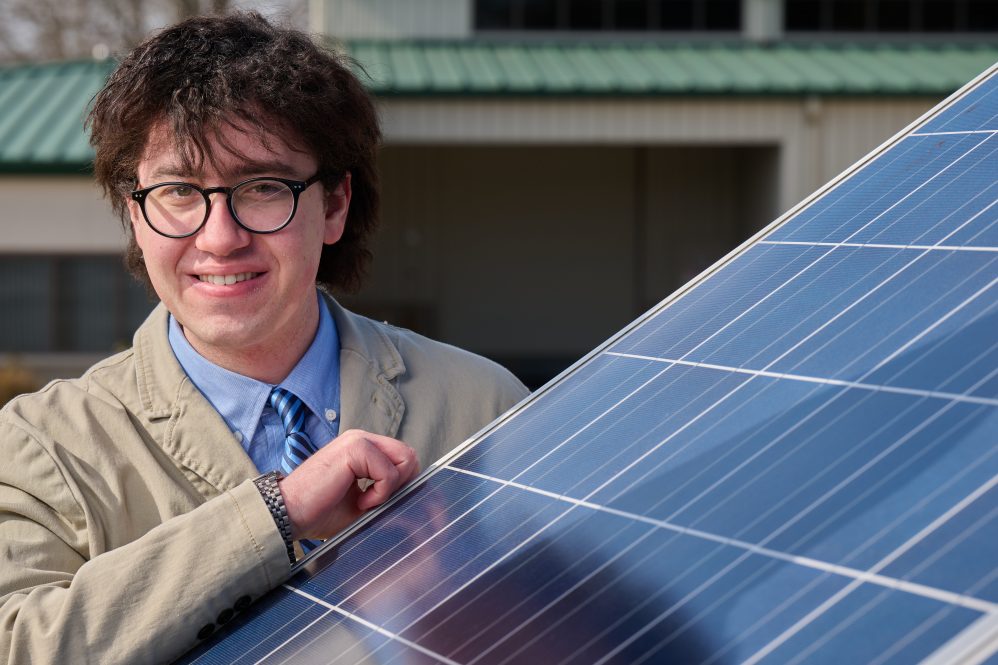Recent political pushes, both nationally and at the state level have made it clear that a transition to clean energy is in our near future. In one of his first actions in office, President Biden signed an executive order to build a new clean energy economy, and in the months since, the administration has continued supporting more clean energy infrastructure. Here in Connecticut, Governor Ned Lamont signed an executive order in 2019 calling for a carbon neutral grid by 2040.
With so much change underway as new programs, initiatives, and incentives roll out, one challenge will be to keep up with the information, another will be getting people behind the efforts in such a massive undertaking. In both cases, UConn students are organizing to help.
The Clean Energy Society, created in the fall of 2021 by Agriculture and Resource Economics student Liam Enea ‘24 (CAHNR) unites many elements, including energy regulation, ratemaking, grid modernization, smart technology, and community engagement. The group aims to build knowledge and action for the fast-growing clean energy sector.
For a large-scale transition, Enea, an operations manager at People’s Action for Clean Energy, stressed in a recent op-ed that messaging is key. Appealing to people’s immediate needs, in the case of Connecticut’s residents, he argues that high electricity costs and dreaded multi-day power outages are the perfect problems to focus on. By presenting clean energy as a solution, it will be easier to get more people on board for the transition.
Those lengthy power outages inspired Enea to learn about solutions, namely generating electricity closer to where people use it.
“Distributed renewable energy could reduce the spread and intensity of outages by bringing generators closer to where people actually use electricity,” Enea says. “The utilities’ strategy of trimming trees around the distribution lines is a band-aid solution.”
Enea is a proponent for solar energy coupled with the capacity for energy storage. He explains that homes and businesses could save money through net metering where the energy they generate can be sold back to the grid at the retail electricity rate. They could also dispatch their energy stores at times when electricity from the grid is more expensive. Communities could even build solar arrays that allow people to receive clean energy credits without having to install solar panels on their roofs.
In the case of power outages, Enea says battery storage means people can use their site-generated, clean energy rather than rely on expensive generators or siting in the dark. Solar and storage could even be used to charge electric vehicles, avoiding their added strain on the grid while cutting gasoline usage.
Enea also saw opportunities for students to have an impact.
“Young people could start the conversation with their town boards of selectmen and join — or form — energy task forces to craft a transition plan,” he says. “There are so many corners of Connecticut where renewable energy isn’t on the agenda because it either seems outside of their jurisdiction, a pointless endeavor, or prone to cost shifting. As soon as those falsehoods are said, everyone backs away from the table. Connecticut, thanks to several factors, has among the highest energy costs and most frequent outages in the nation — we shouldn’t acquiesce.”
Networking is among the first steps the Clean Energy Society is taking. By inviting in professionals to talk about their work, members will learn about the jobs and utility programs driving the clean energy transition. The group also aims to get involved with public policy, testifying and writing in support of doubling the state’s commercial solar caps during this legislative session.
Enea says the group could even be a catalyst for solar development.
“We have so many smart people in this group from unique backgrounds,” he says. “The dream is to navigate the energy matrix in New England, promote existing incentives and programs, and help deploy solar on rooftops, canopies, and brownfields in our towns and elsewhere through public and private dollars.”
Enea also hopes to bring a better understanding of wholesale electricity markets to the group following an internship at ISO New England next summer. He credits his experience so far at UConn and the College of Agriculture, Health, and Natural Resources in helping inspire and support him in his efforts:
“CAHNR’s focus on environmental economics and civics brought me to UConn.”
Ultimately, Enea sees clean, renewable energy as having more benefits than decarbonization.
“I see renewables, particularly solar, as having tremendous benefits that aren’t internalized in energy prices,” he says. “Their capacity is more predictable than oil and natural gas prices. They are the most energy independent thing imaginable and at a time when the bulk of global resources are under risky ground or costly to extract at home, a more diverse energy portfolio could help beat back inflation, ease oil volatility, and protect our country.”
Want to get involved? The Clean Energy Society will meet once a week to learn, advocate, and work in the world of energy. The first meeting of the semester is on Sunday, February 27, 2022 at 4 PM in McHugh 106. For more information, contact Liam Enea at liam.enea@uconn.edu



